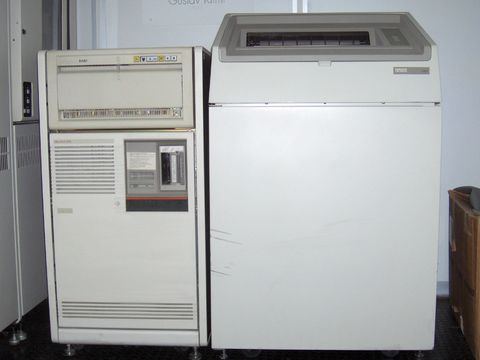 | ||
The MicroVAX was a family of low-cost minicomputers developed and manufactured by Digital Equipment Corporation (DEC). The first model, the MicroVAX I, was introduced in 1984. The MicroVAX family used processors that implemented the VAX instruction set architecture (ISA) and was succeeded by the VAX 4000.
Contents
MicroVAX I
The MicroVAX I, code named "Seahorse", introduced in October 1984, was one of DEC's first VAX computers to use very-large-scale integration (VLSI) technology. The KA610 CPU module (also known as the KD32) contained two custom chips which implemented the ALU and FPU while TTLs were used for everything else. Two variants of the floating point chips were supported, with the chips differing by the type of floating point instructions supported, F and G, or F and D.
MicroVAX II
The MicroVAX II, code named "Mayflower", was a mid-range MicroVAX introduced in May 1985. It ran VAX/VMS or, alternatively, ULTRIX, the DEC native Unix operating system.
It used the KA630-AA CPU module, a quad-height Q22-Bus module, which featured a MicroVAX 78032 microprocessor and a MicroVAX 78132 floating-point coprocessor operating at 5 MHz (200 ns cycle time). Two gate arrays on the module implemented the external interface for the microprocessor, Q22-bus interface and the scatter-gather map for DMA transfers over the Q22-Bus. The module also contained 1 MB of memory, an interval timer, two ROMs for the boot and diagnostic facility, a DZ console serial line unit and a time-of-year clock. A 50-pin connector for a ribbon cable near the top left corner of the module provided the means by which more memory was added to the system.
The MicroVAX II supported 1 to 16 MB of memory through zero, one or two memory expansion modules. The MS630 memory expansion module was used for expanding memory capacity. Four variants of the MS630 existed: the 1 MB MS630-AA, 2 MB MS630-BA, 4 MB MS630-BB and the 16MB MS630-CA. The MS630-AA was a dual-height module, whereas the MS630-BA, MS630-BB and MS630-CA were quad-height modules. These modules used 256 Kb DRAMs and were protected by byte-parity, with the parity logic located on the module. The modules connected to the CPU module via the backplane through the C and D rows and a 50-conductor ribbon cable. The backplane served as the address bus and the ribbon cable as the data bus.
The MicroVAX II came in three models of enclosure:
KA620
KA620 referred to a single-board MicroVAX II designed for automatic test equipment and manufacturing applications which only ran DEC's real-time VAXELN operating system. A KA620 with 1 MB of memory bundled with the VAXELN Run-Time Package 2.3 was priced at US$5,000.
Mira
Mira referred to a fault-tolerant configuration of the MicroVAX II developed by DEC's European Centre for Special Systems located in Annecy in France. The system consisted of two MicroVAX 78032 microprocessors, an active and standby microprocessor in a single box, connected by Ethernet and controlled by a software switch. When a fault was detected in the active microprocessor, the workload was switched over to the standby microprocessor.
Industrial VAX 630
A MicroVAX II in BA213 enclosure.
MicroVAX III
BA23- or BA123-enclosure MicroVAX upgraded with KA650 CPU module containing a CVAX chip set.
MicroVAX III+
BA23- or BA123-enclosure MicroVAX upgraded with KA655 CPU module.
VAX 4
BA23- or BA123-enclosure MicroVAX upgraded with KA660 CPU module.
MicroVAX 2000
The MicroVAX 2000, code named "TeamMate", was a low-cost MicroVAX introduced on 10 February 1987. In January 1987, the MicroVAX 2000 was the first VAX system targeted at both universities and VAX programmers who wanted to work from remote locations.
The MicroVAX 2000 used the same microprocessor and floating-point coprocessor as the MicroVAX II, but was feature reduced in order to lower the cost. Limitations were a reduced maximum memory capacity, 14 MB versus 16 MB in MicroVAX II systems and the lack of Q-Bus or any expansion bus. The system could have two Winchester drives and had a built in 5.25-inch floppy drive for software distribution and backup. Supported operating systems were VMS and ULTRIX. It was packaged in a desktop form factor.
MicroVAX 3100 Series
The MicroVAX 3100 Series was introduced in 1987. These systems were all packaged in desktop enclosures.
MicroVAX 3500 and MicroVAX 3600
The MicroVAX 3500 and MicroVAX 3600, code named "Mayfair", were introduced in September 1987 and were meant to be the higher end complement of the MicroVAX family. These new machines featured more than three times the performance of the MicroVAX II and supported 32 MB of ECC main memory (twice that of the MicroVAX II). The performance improvements over the MicroVAX II resulted from the increased clock rate of the CVAX chip set, which operated at 11.11 MHz (90 ns cycle time) along with a two-level, write-through caching architecture. It used the KA650 CPU module.
MicroVAX 3300 and MicroVAX 3400
The MicroVAX 3300 and MicroVAX 3400, code named Mayfair II, were entry-level to mid-range server computers introduced on 19 October 1988 intended to compete with the IBM AS/400. They used the KA640 CPU module.
MicroVAX 3800 and MicroVAX 3900
The MicroVAX 3800 and MicroVAX 3900, code-named "Mayfair III", were introduced in April 1989. They were high-end models in the MicroVAX family, replacing the MicroVAX 3500 and MicroVAX 3600, and were intended to compete with the IBM AS/400. At introduction, the starting price of the MicroVAX 3800 was US$81,000 and that of the MicroVAX 3900 was US$120,200. A variant of the MicroVAX 3800, the rtVAX 3800, was intended for real-time computing (RTC) applications such as computer-aided manufacturing (CAM). These systems used the KA655 CPU module, which contained a 16.67 MHz (60 ns cycle time) CVAX chip set. They supported up to 64 MB of memory.
